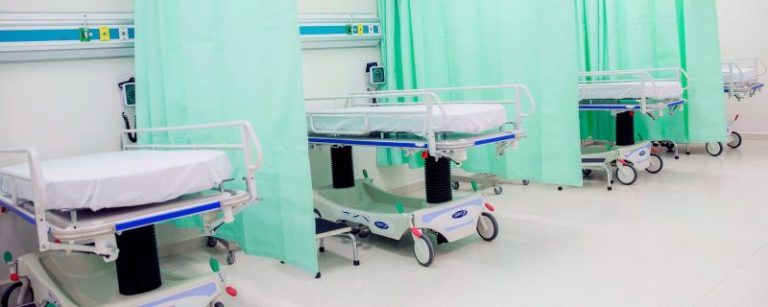Injury care leaders know that higher trauma center volume correlates with better patient outcomes. But what happens when a trauma center gains or loses patient volume over several years? The question is more than just academic. In many regions of the U.S., new trauma centers have cut into patient volumes at long-established trauma programs.
In 2016 a group of researchers at the University of Pittsburgh Medical Center (UPMC) took a close look at the relationship between trauma volume change and patient outcomes. Their findings — published in the Annals of Surgery — demonstrated a link between decreasing trauma center volume and higher mortality rates.
The study was led by Joshua Brown, MD, MSc, a UPMC general surgery resident and trauma research fellow. Dr. Brown recently talked about this research and what it means for trauma system planning.
Q. What was the inspiration for this study?

My colleagues and I had been looking at a lot of literature — both in trauma and in medicine generally — that shows a strong volume-to-outcome relationship. But we noticed that everyone looks at the data as a snapshot in time — meaning that if you are a high-volume center at the time you look at the data, you seem to have better outcomes. So we asked, does it matter how that volume changes over time? Because there may be other things associated with high-volume centers that lead to better outcomes, such as using best practices or being on the cutting edge of other developments.
Q. What did you find?
We found that if a trauma center has increasing volume over time, its patients tend to have improved outcomes. But on the flipside — which was kind of the interesting piece — if you have decreasing volume, your outcomes get worse. And when we compared the two, we found that the magnitude of the decline in outcomes you see if your volumes go down is greater than the benefit you see if your volumes go up.
We also looked at different trauma center levels and how their volume changes affected them. Here, we found that it is really only Level I and II trauma centers that saw a benefit from increasing volume, and there’s a little bit of a time lag before you start to see that benefit.
We also found that the center’s starting point seems to make a difference. If you started at a higher volume and increased your volume even more, you didn’t get quite the same “bang for your buck” in outcomes improvement as the center that started lower or in the middle range of volume and then increased volume. And on the flipside, Level I and II centers didn’t see quite the same decrease in outcomes if they were starting at a higher volume and then went down a little bit.
Q. What does this say about trauma care?
It really points to the multidisciplinary nature of taking care of injured patients. With things like high-risk surgery — for example, coronary bypass — we know the surgeon gets better the more they do. A lot of that has to do with refining your individual surgical technique. But for trauma, there are so many specialties involved in taking care of patients. The fact that only higher-level trauma centers saw a significant benefit is indicative of the accumulation of resources at these centers. It is also indicative of the institutional commitment, where leadership says “we are going to be a trauma center” and invests in taking care of injured patients. So it’s a little bit different from some other areas of medicine where you see this volume-to-outcomes relationship.
Q. You found a “one step forward, two steps back” effect.
At the system level, if you have centers with volume that is going down because one center may be taking patients away from them, the overall net effect on that trauma system would be negative.
Q. However, the study looked only at highly injured patients.
Yes, this study certainly was restricted, and when you look at “all comers” you don’t see quite the same relationship between volume and outcomes. Somebody who is not that seriously injured is probably going to do okay, at least in terms of an outcome like mortality. For this group there is very little risk of dying, so you don’t have the same detriment.
Q. What is the takeaway for trauma system leaders?
I think the takeaway for us is the importance of taking a more “systems” perspective on how we designate centers and put trauma systems together. It’s not to say that any new trauma center is going to bring the whole system down, but I think you have to look at how that trauma center is going to affect the other trauma centers around it.
There are certainly areas of the country that do need more trauma centers and do gain benefit from the addition of Level III and IV centers to stabilize patients and send them on to higher levels of care. I think it’s a balance between providing adequate access to the population and making sure that trauma centers have the appropriate volume to maintain the optimal patient outcomes.
Q. Should the trauma center designation process take “volume change” into account?
I think that could be something to consider. A lot of states and accrediting bodies have taken the approach that if you can “check all the boxes” then you can be a trauma center. One thing I think is moving in the right direction is the American College of Surgeon’s recently published Needs-Based Assessment of Trauma Systems Tool. The tool looks at the overall system picture — how many patients with ISS greater than 15 are in your system, what’s the population size — to try to provide a more objective view of whether or not that system needs more trauma centers. The college is moving toward a more system-based perspective of the verification process, and so a measure like volume change over a period of 3 to 5 years might be one piece that could be helpful for monitoring systems.
Q. What are the next steps for this line of inquiry?
We did this study on a very broad scale, capturing a national picture. Ideally the next step would be to focus on a microcosm and look at processes of care and resources at the hospital level.
In some parts of the country, there has been a fairly rapid expansion of small trauma centers where there are a lot of trauma centers already. In these areas, it would be interesting to look at how processes of care change over time to see whether certain processes or resources fall away or are diverted to other places. I think that would be how we could start to look a little deeper into what might be the underpinnings of these findings.


